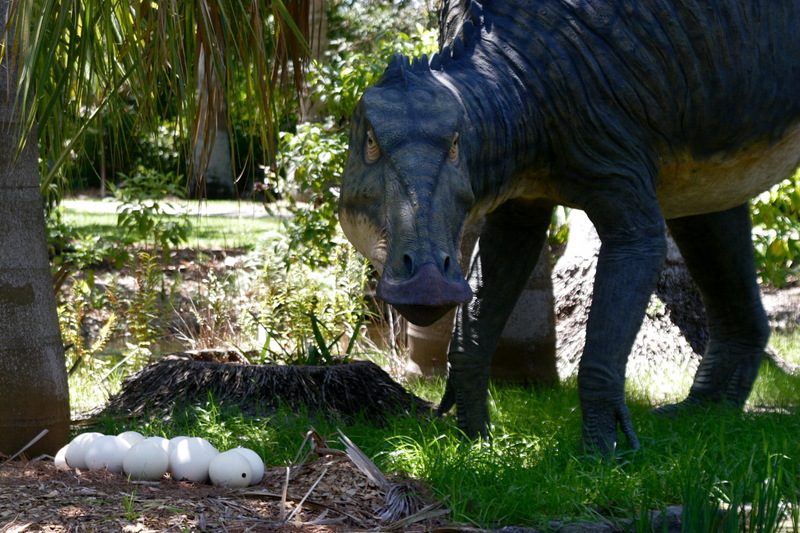ERROR : Server Busy(-1105)
ERROR : Server Busy(-1105)
Edmontosaurus - Wiki
Edmontosaurus
From Wikipedia, the free encyclopedia
[Photo] Edmontosaurus 1:1 model created by Guy Darrough, on temporary exhibit at McKee Botanical Garden, Vero Beach, Florida. Date 2007. Author Robert Lawton http://commons.wikimedia.org/wiki/User:Rklawton
Edmontosaurus (ed-MON-toh-sawr-us) meaning 'Edmonton lizard' (after where it was found, in southern Alberta in what used to be called "Lower Edmonton" in the Horseshoe Canyon Formation, Alberta, Canada and Greek sauros meaning lizard) was a hadrosaurid dinosaur genus from the Maastrichtian, the last stage of the Cretaceous Period, 71-65 million years ago. A fully-grown adult could have been up to 9 metres (30 feet) long and some of the larger specimens reached 12 metres (40 feet). Its weight was in the region of 4.0 tonnes (4.4 short tons), making it one of the largest hadrosaurids. It resembled Maiasaura in its shape and posture, though the size was quite different between the two genera.
Species
Edmontosaurus was erected by Lawrence Morris Lambe in 1917 from a find in the Horseshoe Canyon Formation (then known as the lower Edmonton), Alberta, using E. regalis as type species. Marsh named Claosaurus annectens in 1892, but this has now been reclassified as E. annectens. Likewise, Charles Mortram Sternberg named Thespesius saskatchewanensis in 1926, but this is also now considered to be a species of Edmontosaurus, namely E. saskatchewanensis.
The well-known hadrosaurid genus Anatosaurus has been synonymized with Edmontosaurus. Anatosaurus, meaning "duck lizard", because of its wide, duck-like bill (Latin anato = duck + Greek sauros = lizard). The type species of Anatosaurus, A. annectens, was re-named Edmontosaurus annectens, forcing the name Anatosaurus to be abandoned as a junior synonym. Similarly, Anatosaurus saskatchewanensis was sunk into Edmontosaurus as E. saskatchewanensis. Anatosaurus edmontonensis (or edmontoni) was sunk into E. annectens. Two other species of Anatosaurus, A. longiceps (originally Trachodon) and A. copei (the famous mount at the American Museum of Natural History), were found to differ from Edmontosaurus were placed in a separate genus, Anatotitan.
Characteristics
Edmontosaurus could pass the toughest food back and forth across the teeth with its muscular cheek pouches. To fit so many teeth into its mouth, they were packed into tight "banks" of up to sixty rows, and new teeth constantly grew to replace lost teeth ??? analogous to a modern shark. The bones of the upper jaw would flex outwards as lower jaw came up, so the mandible could grind against it. Typical food would have included conifer needles, seeds and twigs, and these have been found in the body cavities of fossilized edmontosaurs. It was evidently a tree-browser.
The 1908 discovery in Wyoming was especially remarkable in that paleontologists actually recovered fossilized imprints of Edmontosaurus' skin. The impression must have been left by the skin drying very quickly and fixing its shape into the mud. It is from these impressions that we know the skin was scaly and leathery, and the thigh muscle was under the skin of the body. This would have given the impression that the leg left its body at the knee, and the whole thigh was under the skin. This only contributes to its resemblance to a duck. It also had a number of tubercles (bumps) along its neck and down its back and tail.
Edmontosaurus was bipedal but could certainly have walked on four legs. The forelimbs are shorter than the hinds but not sufficiently that four-legged motivation was unfeasible. The front feet also had hooves on two fingers, and weight-bearing pads like those of Camarasaurus. The rear feet had three functional toes and all were hoofed. The bone structure in the lower limbs suggests that both the legs and feet were attached to very powerful muscles. The spine curved downwards at the shoulders, so Edmontosaurus would have had a low posture and would have browsed close to the ground. Despite the power of the limbs, Edmontosaurus would only have been slow-moving and had few defensive features, except, perhaps, its heavy muscular tail and its herd behaviour. To survive, it must have had keen eyesight, hearing and smell to get early warning of predators.
The structure of the skull suggests it may have had loose skin around its wide nasal passages. These could have been inflatable, in order to intimidate other dinosaurs or as part of the mating ritual.
The world of Edmontosaurus
Edmontosaurus existed in the same place and time period as Tyrannosaurus rex and one specimen on display in the Denver Museum of Nature and Science has evidence of a T. rex bite in the tail. The fact that the bone shows evidence of healing suggests that the Edmontosaurus was alive at the time of the bite, and hence that T. rex was probably not a pure scavenger, as had been suggested in the 1970s. A mass graveyard discovery in Alberta, Canada suggests that edmontosaurs lived in herds. These herds may have migrated with the seasons, from the North Slope of Alaska, where plantlife would have been scarce during the dark winter months, to the richer pastures of Alberta. If this is the case, T. rex would probably have gone with it, in search of a relatively easy meal.
In popular culture
Edmontosaurus appeared along side Tyrannosaurus in the Discovery Channel special Dinosaur Planet. It also appeared in the Vivendi Universal game Jurassic Park: Operation Genesis. It also appears in the Discovery Channel special, Valley of the T-Rex, although the footage was off the earlier When Dinosaurs Roamed America episode Anatotitan.
http://en.wikipedia.org/wiki/Edmontosaurus
| The text in this page is based on the copyrighted Wikipedia article shown in above URL. It is used under the GNU Free Documentation License. You may redistribute it, verbatim or modified, providing that you comply with the terms of the GFDL. |
|

